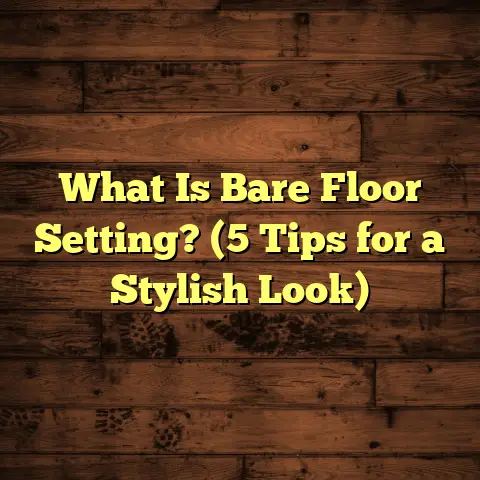What Is a Floor Slab? (5 Key Benefits for Your Construction)
Layering is a concept that often comes up when discussing construction and flooring. It’s all about how different materials are stacked or combined to create a strong, functional base. For me, understanding these layers is crucial because if one isn’t done right, it can affect everything above it. Among these layers, the floor slab stands out as one of the most important. I want to share what a floor slab is and why I consider it a game-changer in construction. Along the way, I’ll dive into the technical side of things, share some of my own experiences, and explain how floor slabs add value to any project.
What Is a Floor Slab?
At its core, a floor slab is a large, flat structural element used to create floors in buildings. Usually made from concrete, it’s designed to carry loads from people, furniture, equipment, and whatever else ends up on it. The slab transfers these loads safely down to the building’s foundation.
But it’s more than just a flat surface. Floor slabs have engineering behind them — they’re carefully designed and built to meet specific strength and durability requirements. The way they’re made involves mixing cement with aggregates such as sand and gravel and reinforcing the concrete with steel bars or mesh. This reinforcement helps prevent cracks and adds tensile strength, which concrete alone lacks.
Types of Floor Slabs
There are different types of floor slabs depending on where and how they’re used:
- Ground-bearing slabs: These are poured directly on a prepared base of soil or compacted gravel. They’re common in residential homes and light commercial buildings.
- Suspended slabs: These don’t rest on the ground but are supported by beams, columns, or walls below. You see these in multi-story buildings.
- Precast slabs: Manufactured off-site in controlled environments and transported to the site for installation. This method speeds up construction.
- Composite slabs: These combine concrete with steel decking or other materials to create a stronger floor system.
Technical Details
To give you an idea of what goes into designing a floor slab, here are some technical specs:
- Thickness: Residential slabs usually range from 100 mm to 150 mm (4 to 6 inches). Commercial or industrial slabs might be 200 mm or thicker.
- Concrete strength: Typically measured in megapascals (MPa). Residential floors often use concrete rated 25 MPa; commercial floors might require 30-40 MPa or higher.
- Reinforcement: Steel bars (rebar) are placed inside the slab before pouring. The amount depends on expected loads but often falls between 0.8% and 1.2% of the slab’s cross-sectional area.
- Curing time: Concrete needs time to harden and gain strength — usually at least 7 days for partial strength and around 28 days for full strength.
- Expansion joints: To accommodate temperature changes and shrinkage, joints or cuts are incorporated to prevent unwanted cracking.
Manufacturing Process
For cast-in-place slabs (the most common), the process looks like this:
- Site preparation: The ground is excavated and leveled. A layer of compacted gravel or crushed stone is added to improve drainage and reduce moisture.
- Formwork setup: Wooden or metal forms create molds that hold the concrete in place until it sets.
- Reinforcement placement: Steel rebar or mesh is laid out according to design specs.
- Pouring concrete: Ready-mix concrete is delivered and poured into forms.
- Compaction and leveling: Vibrators remove air bubbles, and screeding levels the surface.
- Finishing: The surface is smoothed using trowels or special tools.
- Curing: Water is applied regularly or curing compounds used to keep moisture in the slab while it hardens.
Precast slabs follow a similar mixing and curing process but happen in factories with strict quality control before being shipped to the construction site.
Five Key Benefits of Floor Slabs for Your Construction
1. Unmatched Strength and Long-Term Durability
One reason I always recommend floor slabs is their ability to support heavy loads over long periods without failure. Unlike wood, which can warp or rot over time, properly designed concrete slabs last for decades.
In one project I managed for a warehouse facility, we poured a thick reinforced concrete slab designed for forklifts and heavy pallet racks. The slab handled thousands of cycles of heavy loading with no visible cracking after five years.
Here’s a data point: According to industry research, reinforced concrete floors can have service lives exceeding 50 years with routine maintenance. Wood floors typically last 15–30 years before replacement becomes necessary.
Reinforced concrete’s combination of compressive strength from the concrete itself and tensile strength from embedded steel bars creates a composite material that resists bending and cracking under heavy loads.
I’ve also noticed that slabs are resistant to environmental factors — fire, moisture infiltration, chemical spills — which can severely damage other flooring types.
2. Thermal Mass Helps Regulate Indoor Temperatures
Thermal mass refers to a material’s ability to absorb and store heat energy. Concrete slabs excel at this due to their density.
In climates with big temperature swings between day and night, floor slabs absorb heat during the day and slowly release it at night. This natural temperature regulation reduces reliance on heating and cooling systems.
In one cold-weather project I worked on, the homeowner installed radiant heating tubes inside the slab. The slab would warm up slowly but maintain comfortable temperatures evenly throughout the house.
According to studies by building scientists, floors with high thermal mass can reduce heating energy consumption by up to 15%, especially when combined with insulation beneath the slab.
Thermal mass also helps prevent cold spots in rooms and contributes to a more comfortable indoor environment year-round.
3. Design Flexibility for Various Finishes
While some think of concrete slabs as just grey boring floors, they actually provide an excellent base for many flooring types.
You can polish concrete slabs for a sleek modern look — something I installed in an art gallery where visitors loved the glossy finish reflecting light beautifully.
Or cover them with hardwood planks, tiles, carpet, vinyl — the options are almost endless.
Floor slabs also make integrating underfloor heating systems easier because they act as a heat conductor that spreads warmth evenly.
On another jobsite, a client wanted hardwood over their slab but worried about moisture damaging the wood underneath. By installing a proper vapor barrier and moisture-resistant underlayment over the slab, we avoided future problems.
This flexibility makes floor slabs popular across residential, commercial, and industrial projects.
4. Accelerates Construction Timelines
Time saved during construction translates directly into cost savings — something every builder appreciates.
I remember working on a multi-story office building where we used precast floor slabs for quick assembly. The factory-made panels arrived ready to install with reinforcement already set inside.
This approach cut down on formwork setup, pouring time, and curing delays typical with traditional cast-in-place slabs.
Compared to building complex timber framework floors which require skilled carpentry and longer schedules, slabs often simplify project logistics.
When planning budgets now, I use tools like FloorTally that let me input local labor rates and material costs so I can quickly estimate total project expenses with waste factors included — saving me from chasing multiple bids or manually crunching numbers.
5. Superior Resistance Against Moisture and Pests
Moisture-related damage is one of the most common flooring problems I see — warping wood, mold growth, termite infestations.
Concrete slabs act as effective barriers against ground moisture when paired with proper vapor retarders beneath them.
In coastal areas with high humidity or flood-prone zones, I always specify sealed slabs with drainage layers underneath to keep moisture at bay.
One client had recurring termite problems in their home until we replaced their wooden subfloor with a concrete slab sealed against moisture intrusion. Since then, pest issues disappeared entirely.
Sealed floor slabs also reduce mold risk since they don’t absorb water like wood or carpet padding might.
Digging Deeper Into Floor Slab Types and Their Applications
Understanding different floor slab types helps you pick what fits your project best.
Ground-Bearing Slabs
These are poured directly on compacted soil or gravel bases — often seen in single-story homes or light commercial buildings without basements.
The soil must be well-prepared (compacted and leveled) because any settling later can cause cracks.
I once saw a house built without proper soil compaction beneath the slab; within two years cracks appeared due to uneven settling.
Adding a layer of crushed stone beneath the slab improves drainage and prevents water pooling under the floor.
Thickness usually ranges from 100 mm (4 inches) up to 150 mm (6 inches). Reinforcement might be lighter here than suspended slabs since loads are transferred directly to soil.
Suspended Slabs
Used in multi-story buildings or where basements exist. These slabs are supported by beams or columns rather than resting on the ground.
Because they span distances without ground support below, they require thicker sections and heavier reinforcement compared to ground-bearing slabs.
Steel reinforcement layout becomes critical here; spacing between steel bars must be carefully calculated based on span length and anticipated loads.
In high-rise construction I worked on recently, suspended slabs were essential for creating open-plan office spaces without bulky interior walls.
Precast Slabs
Manufactured off-site under controlled conditions for consistent quality. These slabs are shipped ready-made and installed via cranes.
Advantages include faster installation times, less site labor needed, and improved quality control because factory environments avoid weather delays during curing.
I recall working on a retail center where precast slabs allowed us to complete structural framing weeks earlier than originally planned.
Precast options come in various shapes — solid panels, hollow core slabs (with internal voids for weight reduction), ribbed slabs (for extra stiffness).
Composite Slabs
These combine steel decking (corrugated metal sheets) topped with reinforced concrete poured on-site.
Steel decking acts as permanent formwork during pouring and provides tensile reinforcement once cured.
This system allows thinner slabs spanning longer distances — perfect for large commercial spaces needing open floor plans without many supports below.
Material Science Behind Floor Slabs
Understanding what goes into making concrete gives insight into why slabs perform so well.
Concrete is a mix of:
- Cement: Usually Portland cement acts as the binder.
- Aggregates: Sand (fine aggregate) plus gravel or crushed stone (coarse aggregate).
- Water: Reacts chemically with cement through hydration.
- Additives: Like plasticizers improve workability; air entrainers increase frost resistance; fibers reduce cracking.
The key chemical reaction is hydration — cement reacts with water forming calcium silicate hydrate (C-S-H), which binds particles together creating solid mass.
Water-to-cement ratio hugely affects strength — less water means higher strength but reduced workability during pouring.
Steel reinforcement embedded inside counters concrete’s low tensile strength since steel stretches instead of cracking under tension forces.
Additives like fly ash or slag can improve durability by making concrete denser and less permeable to water or chemicals.
Installation Best Practices I Always Follow
From my experience, several factors influence how well a floor slab performs over time:
- Soil preparation: Make sure site soil is properly compacted; consider geotechnical testing for weak soils.
- Vapor barrier installation: Prevent moisture migration up from soil using polyethylene sheets beneath slab.
- Reinforcement placement: Maintain correct spacing; avoid steel touching ground which can lead to corrosion.
- Control joints: Cut joints at specified intervals after curing starts to direct cracking along desired lines.
- Curing methods: Keep slab moist by water spraying or covering with wet burlap/plastic for at least 7 days.
- Slab thickness: Don’t skimp on thickness; follow structural engineer’s guidelines based on expected loads.
- Drainage considerations: Ensure proper grading around building so water doesn’t collect near foundation edges.
I’ve seen projects where skipping vapor barriers led to moldy carpets later on — costly mistakes that could have been prevented by following these steps carefully.
Troubleshooting Common Issues With Floor Slabs
Even well-built slabs can face problems if not maintained properly:
- Cracking: Hairline cracks are normal due to shrinkage but wide cracks may indicate settlement or overload.
- Moisture problems: Signs include efflorescence (white powder), mold growth on finishes.
- Uneven settling: Causes dips or raised spots; often due to poor soil compaction.
- Spalling: Surface flakes off due to freeze-thaw cycles or chemical attack.
Fixes vary from epoxy injections for minor cracks to underpinning foundations if settlement is severe.
In my practice, early detection through regular inspections saves homeowners from expensive repairs down the road.
Cost Considerations Using FloorTally in My Projects
Cost estimation is always tricky when dealing with flooring projects involving slabs because so many variables influence price:
- Material costs fluctuate depending on region and market conditions.
- Labor rates differ based on complexity and local wages.
- Waste factors must be included since some concrete mix gets lost during pouring.
- Additional costs come from reinforcement materials, vapor barriers, finishing treatments.
I rely heavily on tools like FloorTally for quick yet accurate budgeting support. It lets me enter project dimensions, select materials (concrete grade, reinforcement type), input local labor rates, and even factor in waste percentages automatically.
Using this reduces guesswork dramatically compared to manual calculations or relying solely on contractor quotes that might vary widely.
For example:
- A simple residential ground slab might cost between $5-$10 per square foot installed depending on thickness and reinforcement.
- Commercial suspended slabs can run $15-$25 per square foot due to added complexity.
FloorTally’s detailed cost breakdown helps me communicate realistic budgets clearly with clients upfront — avoiding surprises later during construction.
Personal Stories That Highlight Floor Slab Importance
I want to share two quick stories that stick out:
- The House That Settled Too Soon
A friend bought an older home where the floor was uneven and creaked constantly. When we inspected it together, we found that the original builder hadn’t prepared soil properly under the crawl space slab foundation. Over time, parts of the slab settled unevenly causing structural damage upstairs too. It was an expensive repair involving underpinning and partial slab replacement — all avoidable with correct initial layering techniques including soil compaction under the slab layer.
- Polished Concrete Magic
On another occasion I worked on transforming an old warehouse into a retail store. Instead of tearing out all flooring layers, we ground down the existing concrete slab and polished it until smooth as glass. Customers loved how durable yet stylish it looked underfoot — saving thousands on new floor materials while maintaining industrial charm.
Summary Of Takeaways About Floor Slabs
To wrap up what I’ve shared so far:
| Benefit | Explanation |
|---|---|
| Strength & Durability | Supports heavy loads for decades without failure |
| Thermal Mass | Stabilizes indoor temps reducing energy bills |
| Design Flexibility | Works as base for many finishes including radiant heating |
| Faster Installation | Especially with precast panels cuts construction time |
| Moisture & Pest Resistance | Acts as barrier preventing mold & termite damage |
Each point reflects lessons I’ve learned through years in flooring installation combined with technical data from materials science sources.
FAQs About Floor Slabs (Based On My Experience)
Q: How thick should my floor slab be?
A: Depends on load requirements—residential usually 100-150 mm; commercial/industrial thicker—consult your engineer.
Q: Can I install hardwood over a concrete slab?
A: Yes—but install proper moisture barriers first to protect wood from dampness rising through slab.
Q: What causes cracks in floor slabs?
A: Normal shrinkage causes small ones; wide cracks often due to poor soil prep or excessive loads beyond design specs.
Q: Is radiant heating inside floor slabs effective?
A: Very much so—slab’s thermal mass spreads heat evenly creating comfortable warmth indoors.
If you’re thinking about your next flooring project involving floor slabs or want tailored advice based on your site conditions,
feel free to ask me more questions anytime!





